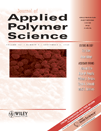Ethylene polymerization by alkylidene-bridged asymmetric dinuclear titanocene/MAO systems
Abstract
Two asymmetric alkylidene-bridged dinuclear titanocenium complexes (CpTiCl2)2(η5-η5-C9H6(CH2)nC5H4), 1 (n = 3) and 2 (n = 4) have been prepared by treating two equivalents of CpTiCl3 with the corresponding dilithium salts of the ligands C9H7(CH2)nC5H5 (n = 3, 4). Additionally, Ti(η5:η5-n-BuC5H4C5H5)Cl2 (3) and Ti(η5:η5-n-BuC9H6C5H5)Cl2 (4) were synthesized as corresponding mononuclear complexes. All complexes were characterized by 1H, 13C NMR, and IR spectroscopy. Homogenous ethylene polymerization catalyzation using those complexes has been conducted in the presence of methylaluminoxane (MAO). The influences of reaction parameters, such as [MAO]/[Cat] molar ratio, catalyst concentration, ethylene pressure, temperature, and time have been studied in detail. The results showed that the catalytic activities of both dinuclear titanocenes were higher than those of the corresponding mononuclear titanocenes. Although the two dinuclear complexes were different in only one [CH2] unit, the catalytic activity of 2 was about 50% higher than that of 1; however, the molecular weight of polyethylene (PE) obtained by 2 was lower than that obtained from 1. The molecular weight distribution of PE produced by these dinuclear complexes reached 6.9 and 7.3, respectively. © 2006 Wiley Periodicals, Inc. J Appl Polym Sci 101: 3317–3323, 2006




